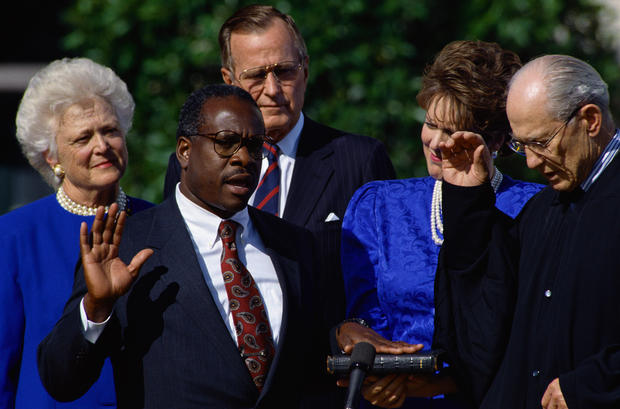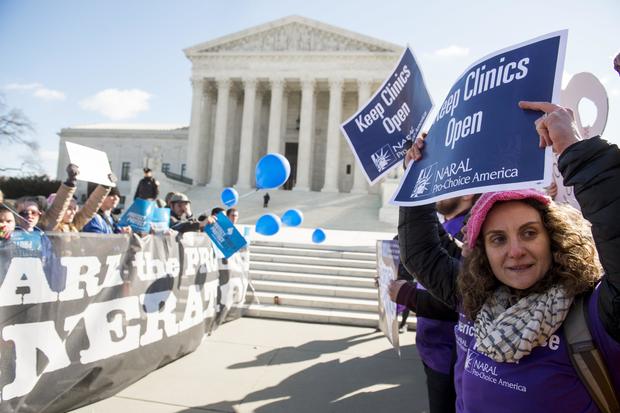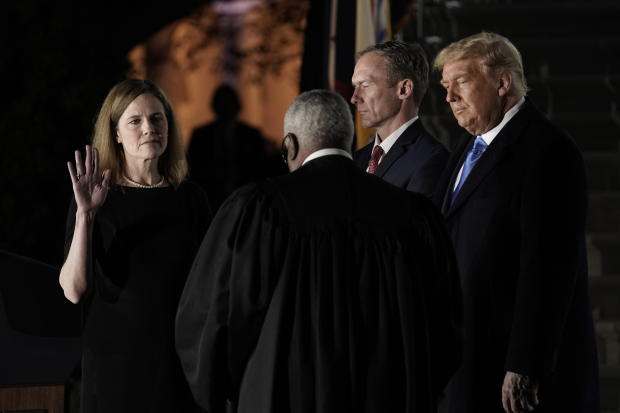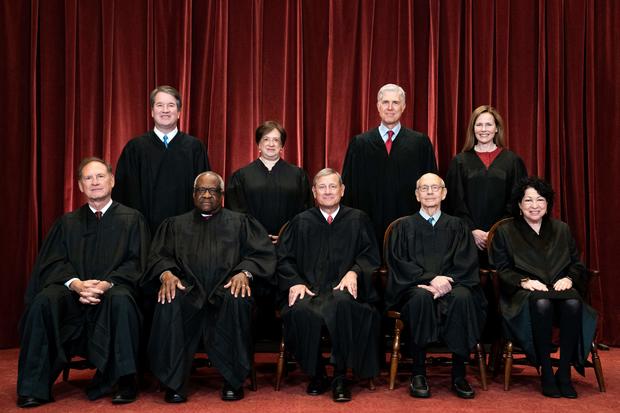Washington — Since the Supreme Court ruled nearly 50 years ago in the case Roe v. Wade that the Constitution protects the right to an abortion, the debate over the issue has raged at the federal and state levels.
But the fight over the constitutional right to an abortion will reach its zenith in the coming weeks, when the Supreme Court will issue its highly anticipated decision in a legal fight over a Mississippi law banning abortions after 15 weeks of pregnancy.
Mississippi officials called for the court, now with a 6-3 conservative majority, to use the case known as Dobbs v. Jackson Women’s Health Organization as a vehicle for overturning its past abortion decisions, and a draft majority opinion circulated among the justices in February that was published by Politico this week suggested the Supreme Court may do just that.
The forthcoming decision follows a decades-long campaign driven by anti-abortion rights advocates to convince the Supreme Court to reverse its 1973 decision in Roe v. Wade, which sparked a host of legal battles as states implemented restrictions that tested the bounds of when the constitutional protection for the right to an abortion is infringed upon.
Here is a look at the key court fights, beginning with Roe, that brought us to this moment in the history of abortion rights in the United States:
March 1970
Jane Roe, now identified as Norma McCorvey, wants to terminate her pregnancy by abortion and files suit against the Dallas County district attorney, arguing Texas’ criminal abortion statutes are unconstitutional and violate her right to privacy under the First, Fourth, Fifth, Ninth and 14th Amendments.
June 1970
A federal district court in Dallas finds the Texas abortion laws to be unconstitutional because “the fundamental right of single women and married persons to choose whether to have children is protected by the Ninth Amendment, through the Fourteenth Amendment,” and the state’s laws infringe upon that right.
January 1973
The Supreme Court rules 7-2 in favor of Jane Roe, establishing the constitutional right to an abortion under the Due Process Clause of the 14th Amendment, which it says protects the right to privacy. The court lays out a trimester framework for when the state, in promoting its interests, can restrict abortion. Justice Harry Blackmun writes the majority opinion, and Justices Byron White and William Rehnquist dissent.
January 1974
The first “March for Life” is held in Washington, D.C. The gathering of anti-abortion rights advocates begins as a way to lobby Congress to find a legislative response to Roe v. Wade, and founder Nellie Gray vows to hold the event each year until the decision is reversed.
September 1976
The so-called “Hyde Amendment,” which bans the use of federal funds for abortions, passes the House for the first time. Named for Rep. Henry Hyde, a Republican from Illinois, the policy is not a law but is included in the Department of Health and Human Services appropriations bill and renewed by Congress each year.
June 1986
Missouri’s governor signs into law legislation that imposes numerous restrictions on abortion, several of which would be the subject of a court battle. The preamble of the statute cites “findings” by the state legislature that “the life of each human being begins at conception,” and that “unborn children have protectable interests in life, health, and wellbeing.” The statute also prohibits the use of public employees and facilities to perform or assist abortions not necessary to save the mother’s life.
1988
The secretary of health and human services issues new regulations to provide “‘clear and operational guidance’ to grantees about how to preserve the distinction between Title X programs and abortion as a method of family planning.” Title X, established in 1970, is a federal grant program that provides lower-income Americans with family planning and preventive health services. The rules specify that a Title X project cannot provide counseling concerning the use of abortion as a method of family planning or provide referral for abortion as a method of family planning; prohibit a Title X project from engaging in activities that “encourage, promote or advocate abortion” as a method of family planning; and require Title X projects be organized so they’re “physically and financially separate” from restricted abortion activities.
1988-1989
Pennsylvania’s legislature amends the Abortion Control Act of 1982 to contain five provisions that are then challenged by abortion clinics and a physician as being unconstitutional. The measures at issue require a woman seeking an abortion to give her informed consent before the procedure, specify she be given certain information at least 24 hours before the abortion, and require the informed consent of one parent for a minor to obtain an abortion. Under a husband-notification requirement, a married woman seeking an abortion must also sign a statement indicating she notified her husband of her intended abortion. The law also imposes reporting requirements on abortion facilities.
July 1989
In its ruling in Webster v. Reproductive Health Services, the Supreme Court upholds the legislation enacted in Missouri that bars public employees and public facilities from being used in performing or assisting abortions unless necessary to save the life of the mother.
May 1991
The Supreme Court issues its decision in Rust v. Sullivan, ruling 5-4 that Department of Health and Human Services regulations restricting Title X grant recipients from engaging in abortion-related activities do not violate the constitutional rights of clients and medical providers.
October 1991
Nominated by President George H.W. Bush, Clarence Thomas is confirmed to the Supreme Court by the Senate.
Wally McNamee/CORBIS/Corbis via Getty Images
June 1992
The Supreme Court issues a divided 5-4 ruling in the case of Planned Parenthood of Southeastern Pennsylvania v. Casey, which involved the provisions enacted by the Pennsylvania legislature in 1988 and 1989. The court upholds rules requiring informed consent before the procedure, a 24-hour waiting period, and for a minor seeking an abortion to obtain the consent of one parent. But it invalidates the husband-notification requirement.
In an opinion authored by Justices Sandra Day O’Connor, David Souter and Anthony Kennedy, the court reaffirms Roe’s central holding, that the Constitution protects the right of a person to have an abortion before viability. But the court rejects the trimester framework in Roe and adopts the “undue burden” standard, under which a state cannot enact a regulation that imposes an undue burden on a woman’s right to an abortion before fetal viability.
Mark Reinstein/Corbis via Getty Images
July 1994
The Senate confirms Stephen Breyer to the Supreme Court. He was appointed by President Bill Clinton.
November 2003
President George W. Bush signs the Partial-Birth Abortion Ban Act into law, prohibiting physicians from performing late-term abortions. The law is swiftly challenged and blocked by federal courts in California, Nebraska and New York.
September 2005
The Senate confirms John Roberts as the 17th chief justice of the United States. He was appointed by President George W. Bush.
January 2006
The Senate confirms Samuel Alito, another Bush nominee, to the Supreme Court.
Chris Maddaloni/Roll Call/Getty Images
April 2007
The court upholds the federal ban on late-term abortions, finding 5-4 in the case Gonzales v. Carhart that it was not unconstitutionally vague and did not impose an undue burden on the right to an abortion.
August 2009
Nominated by President Barack Obama, Sonia Sotomayor is confirmed to the Supreme Court by the Senate.
August 2010
The Senate confirms Elena Kagan to the Supreme Court. She was nominated by Obama.
July 2013
The Texas legislature enacts House Bill 2, which contains two provisions at the center of a legal challenge that ultimately winds up before the Supreme Court. The first requires a physician performing an abortion to have admitting privileges at a hospital no more than 30 miles from the abortion facility. The second requires abortion facilities to meet the minimum standards for ambulatory surgical centers under Texas law. A group of abortion providers in Texas challenges the two requirements, arguing they violated the 14th Amendment under Casey.
June 2014
Louisiana’s governor signs Act 620, which is nearly identical to Texas’s admitting-privileges law. Like the Texas provision, the Louisiana measure requires doctors who perform abortions to hold active admitting privileges at a hospital located within 30 miles of the abortion facility. Abortion clinics and providers challenge the law, arguing it unconstitutionally imposed an undue burden on their patients’ rights to obtain an abortion.
February 2016
Supreme Court Associate Justice Antonin Scalia dies.
SAUL LOEB/AFP via Getty Images
June 2016
The Supreme Court strikes down Texas’s admitting-privileges and surgical-center requirements in the case Whole Woman’s Health v. Hellerstedt, ruling 5-3 they constitute an undue burden on a woman’s constitutional right to an abortion.
April 2017
Tapped by President Donald Trump, Neil Gorsuch is confirmed by the Senate to the Supreme Court to fill Scalia’s seat.
June 2018
Supreme Court Associate Justice Anthony Kennedy announces his retirement.
October 2018
The Senate confirms Trump nominee Brett Kavanaugh to the Supreme Court.
June 2020
Citing its 2016 decision striking down Texas; requirements, the Supreme Court rules 5-4 to invalidate Louisiana’s admitting-privileges law in the case June Medical Services vs. Russo.
Roberts joins the four liberal members of the court in finding the law imposes an undue burden on women seeking pre-viability abortions, as the Texas measure did. While Roberts joined the dissent in Whole Woman’s Health, he said the legal doctrine of stare decisis, or fidelity to precedent, required the court to treat the Texas and Louisiana cases alike. The result in the Louisiana case, he wrote, is controlled by the Supreme Court’s decision four years earlier invalidating the Texas law.
September 2020
Supreme Court Associate Justice Ruth Bader Ginsburg dies.
Ken Cedeno/CNP/Bloomberg via Getty Images
October 2020
The third of Trump’s Supreme Court appointments, Amy Coney Barrett is confirmed by the Senate to the high court, just days before the presidential election. Barrett becomes the sixth conservative on the court, solidifying a majority over the three liberal justices.
May 2021
The Supreme Court agrees to hear a blockbuster dispute involving Mississippi’s law barring abortions after 15 week of pregnancy. Mississippi officials would later ask the justices to overturn Roe and Casey.
September 2021
A Texas law that prohibits abortions once embryonic cardiac activity is detected, typically at around six weeks of pregnancy, is allowed to take effect after the Supreme Court first declines to act on a bid by abortion clinics to block it and then refuses to halt the law. With the Supreme Court’s decision, the Texas measure becomes the most stringent in the nation to be implemented.
The law, known as S.B. 8, has a novel enforcement mechanism under which private citizens, not public officials, enforce the ban by filing lawsuits in state court against anyone who performs an abortion or “aids or abets” them. The measure’s design complicated efforts by the clinics to stop it from taking effect, as it was unclear who they should sue.
After the Justice Department filed its own lawsuit challenging the Texas law, the Supreme Court would go on to hear arguments in that suit and a second from abortion providers. At issue, though, were procedural questions raised by the measure’s enforcement mechanism, including who can sue and when, not whether the ban violates the Supreme Court’s abortion precedents.
Erin Schaff/POOL/AFP via Getty Images
December 2021
The justices hear oral arguments in Dobbs v. Jackson Women’s Health Organization, the court fight over Mississippi’s 15-week ban. During arguments, a majority of the court appears likely to uphold Mississippi’s law, but it is less clear whether there were five votes to undo its earlier abortion decisions.
December 2021
The Supreme Court issues a decision in the disputes over Texas’ S.B. 8 and limits who abortion clinics can sue to state licensing officials. While the court did say the clinics’ suit against “executive licensing officials” can proceed, it leaves the law in place while proceedings continue. The court also dismisses the Justice Department’s challenge.
May 2022
Politico publishes a 98-page draft opinion written by Alito in the Mississippi case that would strike down Roe and Casey if finalized by a majority of justices. Alito writes that Roe was “egregiously wrong from the start” and “must be overruled.”
“The Constitution makes no reference to abortion, and no such right is implicitly protected by any constitutional provision, including the one on which the defenders of Roe and Casey now chiefly rely — the Due Process Clause of the Fourteenth Amendment,” Alito writes. “That provision has been held to guarantee some rights that are not mentioned in the Constitution, but any such right must be ‘deeply rooted in this Nation’s history and tradition’ and ‘implicit in the concept of ordered liberty’ … The right to abortion does not fall within this category.”
The leak of the draft opinion, unprecedented in modern times, sets off a firestorm of controversy and protests from supporters of abortion rights and Democratic lawmakers. Roberts, the chief justice, says the leak is a “betrayal” of trust and orders an investigation into its release.
The Supreme Court’s final ruling is expected by the end of the court’s term, in late June or July.





